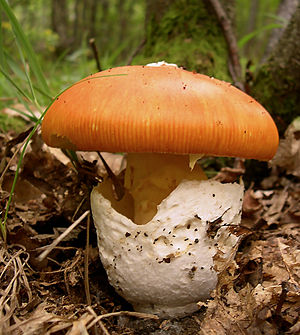Kaiserling
| Kaiserling | ||||||||||||
|---|---|---|---|---|---|---|---|---|---|---|---|---|

Kaiserling ( Amanita caesarea ) |
||||||||||||
| Systematics | ||||||||||||
|
||||||||||||
| Scientific name | ||||||||||||
| Amanita caesarea | ||||||||||||
| ( Scop. ) Pers. |
The emperor Ling ( Amanita Caesarea ), also Emperor Mushroom or Orange Yellow Amanita called, is a type of fungus from the family of Wulstlingsverwandten (Amanitaceae) of a exceptionally tasty since antiquity the reputation of edible fungus enjoys.
features
The Kaiserling is a leaf mushroom with fruiting bodies divided into a hat and stem. The hat is about 7 to 15, in exceptional cases 18 centimeters wide. Young at first club-like to egg-shaped and wrapped in a thick white velum universale , the hat shields in old age. Its surface is bright orange-red in color and often fades yellowish towards the edge of the hat, slightly greasy when damp, silky, shiny, smooth and grooved on the edge when dry. A few white rags of the velum rarely remain on the surface of the hat. The lemon to golden yellow stalk is about 8 to 15 centimeters long and 2 to 3 centimeters thick; Towards the tip it tapers somewhat, but at the base it is thickened in a bulbous manner. Its surface is fine-fibrous-flaky beneath the permanent, hanging, superficially grooved, smooth, golden-yellow cuff on the underside . The stalk is in a sack-like, lobed, thick-skinned, white to gray-white volva . The lamellae are light yellow when young and turn golden yellow with increasing maturity. The spore powder is white. The otherwise white meat shows a yellow color under the hat skin. The smell is pleasant, the taste mild and nutty.
Species delimitation
The poisonous toadstool is a much more common red-capped European Amanita species. It is often distinguished by white velum scales on the hat skin, which can also be easily wiped off or washed off by rain. The stem and lamellae are pronounced yellow to whitish-yellow in the Kaiserling and white in the fresh toadstool fruit body at least. Furthermore, the Kaiserling has a free and well-developed, upright volva; in the toadstool, on the other hand, the remains of the volva are formed as wreaths of adjacent wart belts. The cell material of the Velum universale in the fly agaric contains inflated hyphae elements and spherocysts.
In addition, the Kaiserling, especially young, can be confused with the orange-yellow and the fox-like sheath streifling . However, these have white lamellas and stem, and never a ring.
ecology
The Kaiserling is a mycorrhizal fungus that can be associated with oaks , beeches , pines and chestnuts . It loves warmth and grows in light forests and bushes. In Central Europe it grows on weakly to strongly acidic, fresh soils that are only slightly supplied with bases. The fruiting bodies appear from summer to autumn, provided that there was sufficient rainfall beforehand .
distribution
The Kaiserling occurs in the Holarctic in the Mediterranean to warm temperate zones: in Europe, the Caucasus, Japan, East Asia, North America (Mexico to Canada) and North Africa (Morocco and Algeria). In Europe it occurs in the south of Spain, on Corsica, in Italy, on the Balkan Peninsula and in Central Europe from southern France to Hungary and the Czech Republic, rarely to southern Poland. The species is rare north of the Alps. In Germany the Kaiserling occurs unsteadily. There are sites in Baden-Württemberg, Bavaria, Rhineland-Palatinate and Hesse, in rare cases the species was also found in Saxony. Breitenbach and Kränzlin assume that the occurrences north of the Alps go back to carry-overs from Roman times, as it mainly occurred along the old Roman roads.
Systematics
Numerous similar species are known worldwide. However, the exact relationship has not yet been clarified. The species group around the Kaiserling consists of five species. The group around the similar Tibetan emperor ( A. hemibapha ) includes around 40 species.
meaning
The mushroom, which is very seldom fructifying in Central Europe due to the climatic conditions, has been a highly valued edible mushroom since ancient times, and is occasionally traded as a market mushroom south of the Alps and in the border triangle near Basel . According to Appendix 1 of the Federal Species Protection Ordinance , the Kaiserling is particularly protected and may therefore not be collected anywhere in Germany.
Web links
swell
- German Josef Krieglsteiner (Ed.), Andreas Gminder : Die Großpilze Baden-Württemberg . Volume 4: Mushrooms. Blattpilze II. Ulmer, Stuttgart 2003, ISBN 3-8001-3281-8 .
- Josef Breitenbach, Fred Kränzlin (Ed.): Mushrooms of Switzerland. Contribution to knowledge of the fungal flora in Switzerland. Volume 4: Agarics. Part 2: Entolomataceae, Pluteaceae, Amanitaceae, Agaricaceae, Coprinaceae, Bolbitiaceae, Strophariaceae. Mykologia, Luzern 1995, ISBN 3-85604-040-4 .
- Thomas Lehr: Amanita caesarea (Scop.:Fr.) Pers. , on fundkorb.de.
Individual evidence
- ↑ Moser 1983, page 222.
- ^ Breitenbach, Kränzlin, 1995
- ↑ C. Hahn, S. Raidl and L. Beenken 2000 in Zeitschrift für Mykologie, Volume 66/2, page 173, http://www.dgfm-ev.de/sites/default/files/ZM662173Hahn.pdf .
- ↑ Amanita caesarea at Amanitaceae.org
